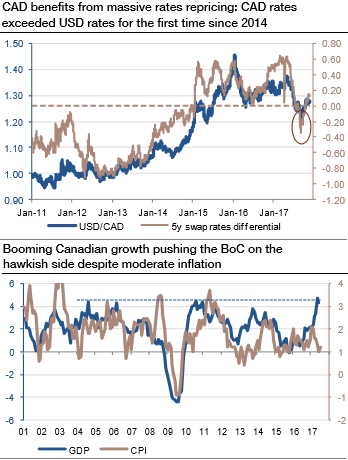U.S. West Texas Intermediate (WTI) crude futures are hovering at $64.14, down 23 cents from their last settlement. Commodity trading has slightly been tepid due to a national holiday in the United States.
Crude Oil demand has been intensified considerably in the recent times by the exceptional winter in Northern America. This seasonal impulse adds to robust economic activity that has lifted growth expectations for 2018 and beyond. Furthermore, the continued upside surprises in economic activity evident in the global economy run counter to the weakness seen in Chinese data (refinery runs and crude imports)for July and August, which hinted at slowing growth rates, (refer above diagram).
As per JPM, US heating oil demand has received a boost from the colder weather in recent weeks. Deliveries of middle distillates were 537 kbd (+16%) higher YoY over the past three weeks. Although diesel accounts for the vast majority of middle distillate demand the seasonal surge in heating related demand boosts an already strong baseline. As measured by heating degree days, (HDD), heating demand was 55% above the five year average in early January. US HDD data from the National Oceanic and Atmospheric Administration (NOAA) reached 362 for the week ending4 January, as compared to a five year average of 255and is expected to be high in Feb as well according to our weather analyst, (refer above diagram).
The total North Sea loadings in December were down by 18.6% YoY due to Forties pipeline shutdown. North Sea loadings numbers for Jan’18 and Feb’18 are down by 11.5% YoY and 5.7% YoY, indicating some lingering constraint to loadings from recent disruption, exhibit 8. In addition to that, Libyan pipeline blast led to the reduction in oil exports by 100 kbd according to the Libyan NOC at the end of Dec’17. This has tightened the physical markets in addition to the extension of OPEC and Russia’s strong commitment to extending the scale back in oil production. Freezing winter weather conditions are further expected to impact supplies in the US, although not as significantly as suggested by latest US weekly data.
3m rolling oil dollar correlation has been at -0.4. It is still not as strong as seen in Sep’17. The causality is still unclear whether the weakness in the dollar is caused by strength in global economy outside of US which is also reflective of strong oil demand. Nevertheless, the dollar’s strong negative correlation is becoming apparent since the end of 2017 once again, (refer 3rd diagram).
We’ve already advocated adding longs using futures contracts of near-month tenors with a view to arresting upside risks, we reiterate that it is wise to use dips to deploy long hedges using these WTI derivative contracts but using mid-month tenors as well.
Go long Mar’18 NYMEX WTI vs ICE Brent spreads at -$5.81/bbl. Trade target of $4.8/bbl and stop loss of -$6.1/bbl.



 China’s Growth Faces Structural Challenges Amid Doubts Over Data
China’s Growth Faces Structural Challenges Amid Doubts Over Data  Stock Futures Dip as Investors Await Key Payrolls Data
Stock Futures Dip as Investors Await Key Payrolls Data  Oil Prices Dip Slightly Amid Focus on Russian Sanctions and U.S. Inflation Data
Oil Prices Dip Slightly Amid Focus on Russian Sanctions and U.S. Inflation Data  Fed May Resume Rate Hikes: BofA Analysts Outline Key Scenarios
Fed May Resume Rate Hikes: BofA Analysts Outline Key Scenarios  2025 Market Outlook: Key January Events to Watch
2025 Market Outlook: Key January Events to Watch  Lithium Market Poised for Recovery Amid Supply Cuts and Rising Demand
Lithium Market Poised for Recovery Amid Supply Cuts and Rising Demand  ETHUSD Defies ETF Outflows: Holds Above $3000, Bulls Eye $3200 Breakout
ETHUSD Defies ETF Outflows: Holds Above $3000, Bulls Eye $3200 Breakout  Asian Fund Managers Turn More Optimistic on Growth but Curb Equity Return Expectations: BofA Survey
Asian Fund Managers Turn More Optimistic on Growth but Curb Equity Return Expectations: BofA Survey  Gold Prices Slide as Rate Cut Prospects Diminish; Copper Gains on China Stimulus Hopes
Gold Prices Slide as Rate Cut Prospects Diminish; Copper Gains on China Stimulus Hopes 






























